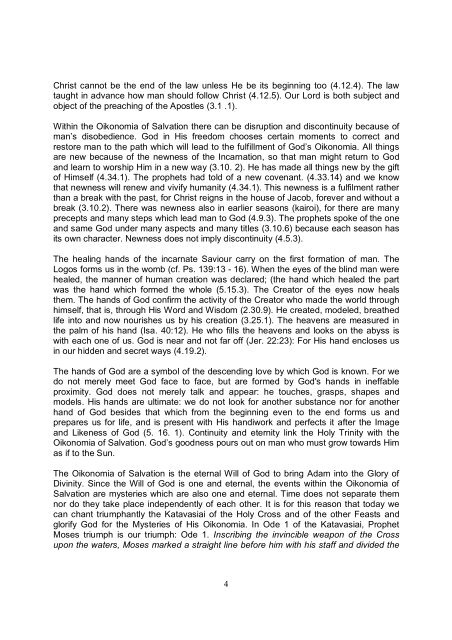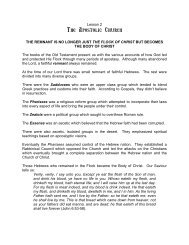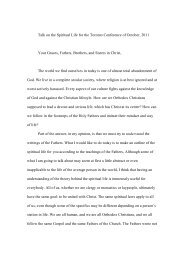According to the Scriptures - Saint Nektarios Greek Orthodox Church
According to the Scriptures - Saint Nektarios Greek Orthodox Church
According to the Scriptures - Saint Nektarios Greek Orthodox Church
Create successful ePaper yourself
Turn your PDF publications into a flip-book with our unique Google optimized e-Paper software.
Christ cannot be <strong>the</strong> end of <strong>the</strong> law unless He be its beginning <strong>to</strong>o (4.12.4). The law<br />
taught in advance how man should follow Christ (4.12.5). Our Lord is both subject and<br />
object of <strong>the</strong> preaching of <strong>the</strong> Apostles (3.1 .1).<br />
Within <strong>the</strong> Oikonomia of Salvation <strong>the</strong>re can be disruption and discontinuity because of<br />
man’s disobedience. God in His freedom chooses certain moments <strong>to</strong> correct and<br />
res<strong>to</strong>re man <strong>to</strong> <strong>the</strong> path which will lead <strong>to</strong> <strong>the</strong> fulfillment of God’s Oikonomia. All things<br />
are new because of <strong>the</strong> newness of <strong>the</strong> Incarnation, so that man might return <strong>to</strong> God<br />
and learn <strong>to</strong> worship Him in a new way (3.10. 2). He has made all things new by <strong>the</strong> gift<br />
of Himself (4.34.1). The prophets had <strong>to</strong>ld of a new covenant. (4.33.14) and we know<br />
that newness will renew and vivify humanity (4.34.1). This newness is a fulfilment ra<strong>the</strong>r<br />
than a break with <strong>the</strong> past, for Christ reigns in <strong>the</strong> house of Jacob, forever and without a<br />
break (3.10.2). There was newness also in earlier seasons (kairoi), for <strong>the</strong>re are many<br />
precepts and many steps which lead man <strong>to</strong> God (4.9.3). The prophets spoke of <strong>the</strong> one<br />
and same God under many aspects and many titles (3.10.6) because each season has<br />
its own character. Newness does not imply discontinuity (4.5.3).<br />
The healing hands of <strong>the</strong> incarnate Saviour carry on <strong>the</strong> first formation of man. The<br />
Logos forms us in <strong>the</strong> womb (cf. Ps. 139:13 - 16). When <strong>the</strong> eyes of <strong>the</strong> blind man were<br />
healed, <strong>the</strong> manner of human creation was declared; (<strong>the</strong> hand which healed <strong>the</strong> part<br />
was <strong>the</strong> hand which formed <strong>the</strong> whole (5.15.3). The Crea<strong>to</strong>r of <strong>the</strong> eyes now heals<br />
<strong>the</strong>m. The hands of God confirm <strong>the</strong> activity of <strong>the</strong> Crea<strong>to</strong>r who made <strong>the</strong> world through<br />
himself, that is, through His Word and Wisdom (2.30.9). He created, modeled, brea<strong>the</strong>d<br />
life in<strong>to</strong> and now nourishes us by his creation (3.25.1). The heavens are measured in<br />
<strong>the</strong> palm of his hand (Isa. 40:12). He who fills <strong>the</strong> heavens and looks on <strong>the</strong> abyss is<br />
with each one of us. God is near and not far off (Jer. 22:23): For His hand encloses us<br />
in our hidden and secret ways (4.19.2).<br />
The hands of God are a symbol of <strong>the</strong> descending love by which God is known. For we<br />
do not merely meet God face <strong>to</strong> face, but are formed by God's hands in ineffable<br />
proximity. God does not merely talk and appear: he <strong>to</strong>uches, grasps, shapes and<br />
models. His hands are ultimate: we do not look for ano<strong>the</strong>r substance nor for ano<strong>the</strong>r<br />
hand of God besides that which from <strong>the</strong> beginning even <strong>to</strong> <strong>the</strong> end forms us and<br />
prepares us for life, and is present with His handiwork and perfects it after <strong>the</strong> Image<br />
and Likeness of God (5. 16. 1). Continuity and eternity link <strong>the</strong> Holy Trinity with <strong>the</strong><br />
Oikonomia of Salvation. God’s goodness pours out on man who must grow <strong>to</strong>wards Him<br />
as if <strong>to</strong> <strong>the</strong> Sun.<br />
The Oikonomia of Salvation is <strong>the</strong> eternal Will of God <strong>to</strong> bring Adam in<strong>to</strong> <strong>the</strong> Glory of<br />
Divinity. Since <strong>the</strong> Will of God is one and eternal, <strong>the</strong> events within <strong>the</strong> Oikonomia of<br />
Salvation are mysteries which are also one and eternal. Time does not separate <strong>the</strong>m<br />
nor do <strong>the</strong>y take place independently of each o<strong>the</strong>r. It is for this reason that <strong>to</strong>day we<br />
can chant triumphantly <strong>the</strong> Katavasiai of <strong>the</strong> Holy Cross and of <strong>the</strong> o<strong>the</strong>r Feasts and<br />
glorify God for <strong>the</strong> Mysteries of His Oikonomia. In Ode 1 of <strong>the</strong> Katavasiai, Prophet<br />
Moses triumph is our triumph: Ode 1. Inscribing <strong>the</strong> invincible weapon of <strong>the</strong> Cross<br />
upon <strong>the</strong> waters, Moses marked a straight line before him with his staff and divided <strong>the</strong><br />
4





